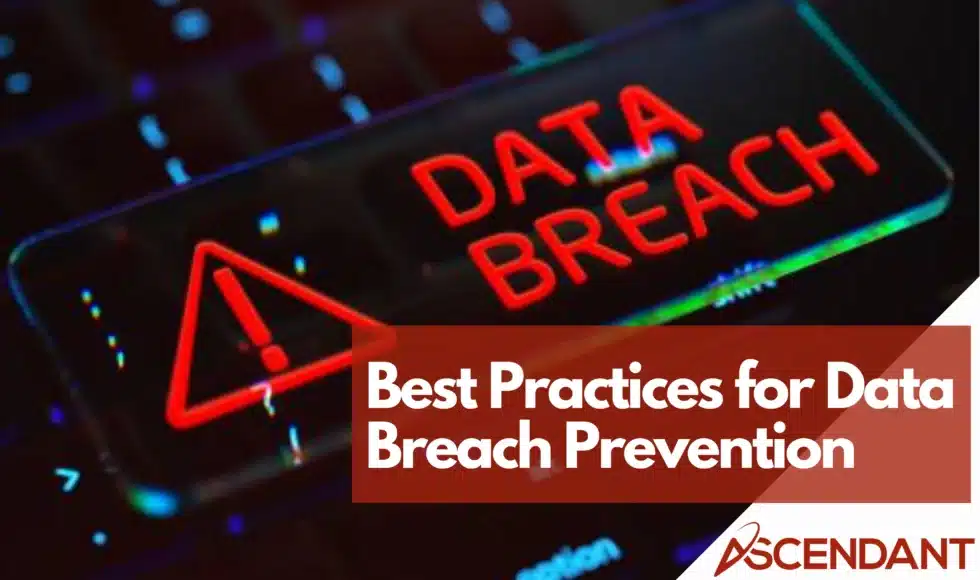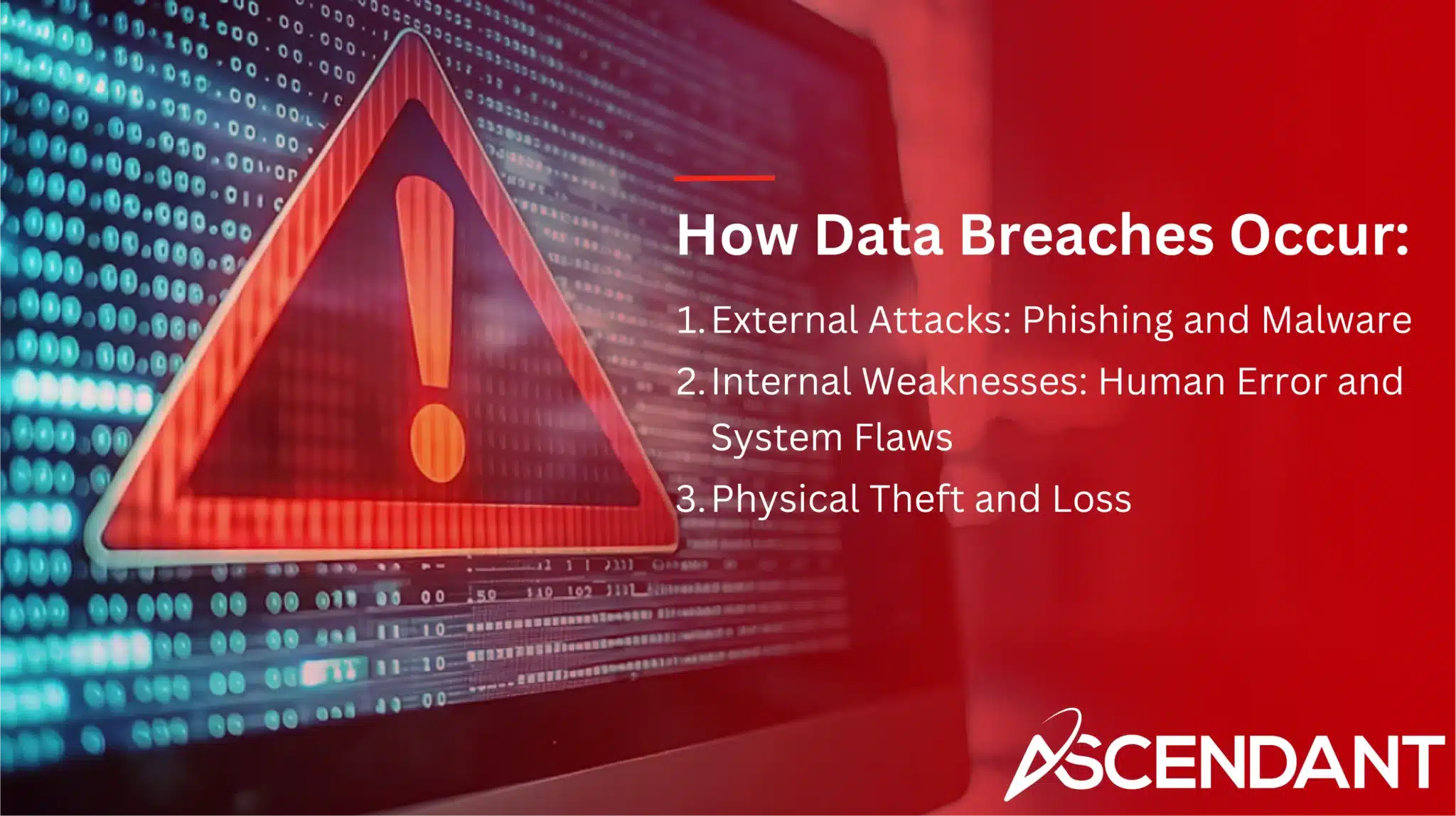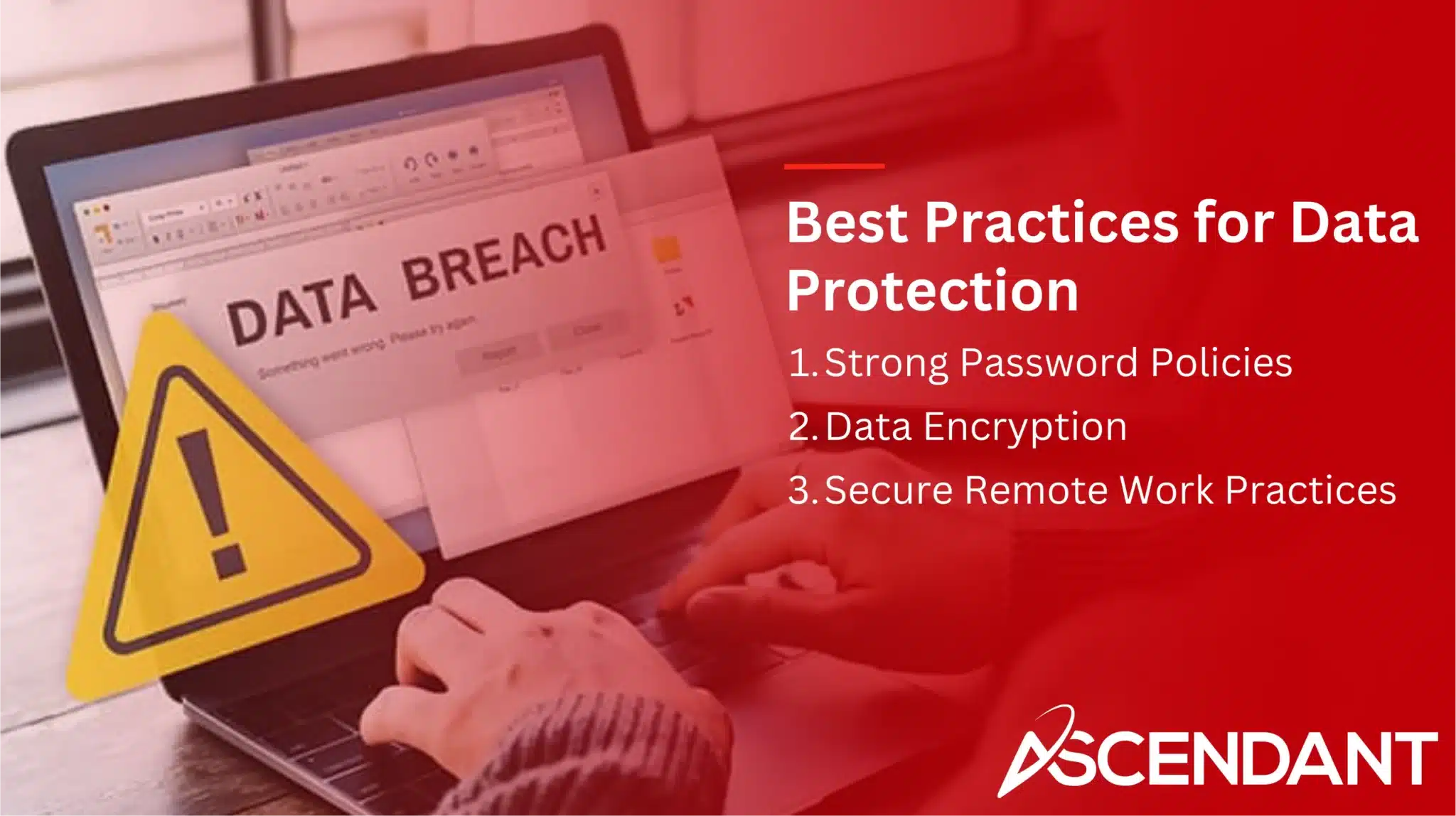A data breach involves unauthorized access to sensitive data, causing financial and reputational harm. This article will teach you 10 key practices to prevent data breaches and protect your information effectively.
Key Takeaways
- Data breaches can occur due to external attacks, internal weaknesses, and physical theft, emphasizing the importance of comprehensive security strategies.
- Organizations can mitigate the impact of data breaches through employee training, regular security audits, and the implementation of multi-factor authentication.
- Legal compliance and engagement with cybersecurity experts are essential for effectively managing data protection and responding to emerging threats.
How Data Breaches Occur
Incidents of data breaches occur when there is an illicit intrusion, theft or exposure of confidential information. These events can arise from both inside and outside sources that often exploit weaknesses in systems or operational protocols. Recognizing how these security breaches transpire and identifying the moment a breach takes place are crucial for devising robust countermeasures.
Factors contributing to data breach incidents include insufficiently strong passwords and outdated software. Additional risks include phishing schemes, employee oversight or malicious acts, insecure networks, as well as sharing sensitive details with external entities. Such vulnerabilities may result in considerable losses of data along with unauthorized entry into systems—illustrated by the notorious Equifax incident, which was precipitated by an unpatched flaw within third-party software.
Data breaches typically unfold through one of three avenues: invasions instigated externally (like malware attacks), vulnerabilities stemming internally (due to mistakes made by humans or systemic inadequacies), plus physical misplacement or outright stealing of hardware holding critical information. Addressing each channel’s unique challenges necessitates tailored strategies to thwart potential data breach attacks effectively. Let’s delve into examining these scenarios individually.
External Attacks: Phishing and Malware
Data breaches often occur due to external assaults, with phishing and malware being notable techniques employed by cybercriminals seeking unauthorized access to sensitive data. Phishing involves masquerading as a trustworthy source in order to deceive individuals into divulging sensitive information. Cyber criminals exploit this strategy through sophisticated social engineering tactics aimed at collecting personal details for identity theft or sale.
In contrast, malware is malicious software that infiltrates systems via deceptive links in emails or websites. Once activated, it provides attackers with unauthorized entry points to obtain sensitive data and execute data breaches.
To combat these pernicious threats which pose significant risks to both corporations and private citizens, it’s crucial for enterprises to fortify their defenses with advanced security measures while also educating staff on how to identify and elude the traps set by phishing schemes and malware intrusions.
Internal Weaknesses: Human Error and System Flaws
Another primary source of data breaches are internal vulnerabilities that include human error and flaws within the system. A considerable amount of these security incidents arise due to mistakes made by individuals, such as sending sensitive data to incorrect recipients or not securing it adequately. Even minor oversights like sending confidential information erroneously can lead to a breach in security, jeopardizing delicate data.
Vulnerabilities such as software misconfigurations and defects in systems open up opportunities for unauthorized access. The threat posed by insiders who may deliberately divulge or pilfer their employer’s sensitive information underscores the necessity for ongoing education and surveillance.
Mitigating these internal shortcomings is crucial for bolstering data protection measures and plays a pivotal role in averting future breaches of sensitive information.
Physical Theft and Loss
Neglecting the physical security of devices can create serious risks for data breaches. Devices such as laptops, smartphones, and external hard drives that are lost or stolen can become gateways for unauthorized access to sensitive data if they are not adequately protected. Without detection, cybercriminals may exploit these tangible assets leading to identity theft and significant loss of sensitive information.
The risk extends beyond electronic gadgets to include paper documents containing critical information. Unauthorized parties gaining possession of these materials due to device or document theft could result in compromising personal details and triggering both identity theft and data leakage.
By implementing strong passwords and installing anti-theft software on portable devices we can thwart attempts by intruders trying to gain unauthorized access thereby safeguarding against exposure of sensitive material from being compromised through misplaced or purloined items.
The Impact of Data Breaches
The repercussions of data breaches can stretch widely, impacting organizations and people alike. Companies may face a substantial financial toll when they fall victim to such incidents. The average breach costs approximately $3.86 million. In 2020, companies that shifted to remote work encountered an additional burden averaging an extra $137,000 per incident in expenses. Episodes like Equifax’s mishap – which compromised the personal details of over 153 million people – illustrate how these events can tarnish a company’s reputation and erode consumer confidence.
It takes about 280 days on average for an organization to detect and control a data breach, adding insult to injury regarding public image issues stemming from these security lapses. Exposing sensitive data—ranging from banking credentials to Social Security numbers—these breaches leave individuals susceptible to identity theft along with potential monetary losses.
As evidenced by the First American Financial catastrophe, where upwards of 885 million critical documents were disclosed publicly, it’s clear that enduring multiple data leaks poses significant dangers not just for corporations, but also for private citizens who might find their most confidential information revealed without consent.
Business Consequences
Businesses may suffer considerable financial repercussions from data breaches, including the expenses associated with remediation and potential penalties imposed by regulators. When a business experiences a breach involving confidential information, its reputation can take a severe hit, leading to diminished customer confidence that is challenging to restore. The detrimental impact of such high-profile incidents is often exacerbated when they involve the release of private personal details like Social Security numbers and credit card data.
It’s crucial for organizations to have an established protocol for communicating with customers and staff in the aftermath of a data breach. A swift and transparent approach to addressing the issue can help lessen reputational harm while laying the groundwork for regaining stakeholder trust.
Individual Consequences
People who suffer from data breaches can experience serious repercussions, such as identity theft and financial turbulence. Cyber criminals may exploit purloined personal data to impersonate individuals, gain entry into social platforms, and decimate credit scores. This kind of illicit activity can inflict long-standing harm on the lives of those affected.
Identity theft has the potential to deeply impact an individual’s credit score and fiscal solidity in a detrimental way. Rectifying these issues usually requires extensive effort and resources. To defend against such risks, it is critical for people to protect their private information diligently and remain alert to possible dangers.
Essential Security Measures
To safeguard sensitive data and thwart data breaches, it’s imperative to put in place critical security measures. Establishing a multi-tiered defensive framework bolsters the defense against threats that may originate from within or outside an organization. Tools designed for network protection and cutting-edge threat recognition, in conjunction with a dedicated internet security team, are instrumental in scrutinizing network traffic and pinpointing potential malevolent actions early on.
Employing cybersecurity professionals who possess the requisite expertise is essential for preemptively spotting weaknesses and deploying appropriate protective mechanisms. Such forward-looking vigilance ensures stringent management of data protection protocols. The commitment to hiring adept cybersecurity staff enables organizations to keep pace with newly emerging threats while upholding comprehensive security strategies.
Employee Training and Awareness
Ensuring that employees are well-informed about data security is vital because they commonly serve as the initial barrier against data breaches. Through education, workers become equipped to identify phishing attempts, establish robust passwords, and comprehend the dangers associated with unsecure websites. The utilization of engaging training techniques like games and simulations can greatly boost involvement in cybersecurity awareness.
Providing consistent training empowers staff members to detect and react appropriately to security threats, which minimizes the likelihood of mistakes due to human oversight or internal risks. It’s imperative for employees to recognize their pivotal role in thwarting data breaches by upholding secure practices within human services environments.
Regular Security Audits
It is essential to conduct security audits routinely as they play a pivotal role in detecting vulnerabilities and guaranteeing adherence to established security protocols. Engaging in annual audit practices contributes significantly to preserving data safety and pinpointing areas susceptible to exploitation. Utilizing automated instruments for these audits fosters consistent vulnerability detection, thereby fortifying the general state of protection.
Establishing an explicit procedure for data auditing is beneficial in grasping the nature of personal information retained by an entity and the methods employed in its governance. Through periodic reviews of their security strategies, entities can reveal and rectify any neglected flaws, thus averting possible incidents involving unauthorized access or compromise of sensitive data.
Multi-Factor Authentication
Requiring users to present several verification methods, multi-factor authentication (MFA) substantially diminishes the chances of unauthorized access. By adopting MFA, protection against illicit entry is strengthened for sensitive data—even when login credentials fall into the wrong hands.
Strengthening overall data security can be achieved by combining MFA with robust passwords and password management tools. To protect accounts from unsanctioned intrusions and decrease the likelihood of data breaches, organizations are advised to promote the use of MFA among their workforce.
Best Practices for Data Protection
Adhering to top-tier data protection protocols plays a pivotal role in thwarting data breaches and securing sensitive information. The application of multilayered security strategies fortifies the defense against unauthorized access, making it more challenging for intruders to compromise systems. Essential steps organizations need to take include the implementation of multi-factor authentication, purging redundant data, and maintaining regular backups.
Allocating resources both financially and temporally toward enhancing security measures is crucial for mitigating risks associated with data breaches while adjusting to the dynamic nature of cyber threats. Encryption is highly recommended as a method for safeguarding private information when it’s being transmitted.
Strong Password Policies
Employing distinct, intricate passwords for each account considerably diminishes the likelihood of sensitive data being compromised by unauthorized access. It is advisable to implement passwords with at least 16 characters that integrate a combination of upper and lower case letters, numerals, and symbols.
To aid in upholding robust and individualized password usage among employees, leveraging a password manager contributes substantially to bolstering data security measures. Establishing stringent password protocols is essential in safeguarding sensitive data against unsanctioned entry.
Data Encryption
The protection of sensitive data from unauthorized access is critically upheld through the application of data encryption. By encrypting data in transit, it ensures that sensitive information remains secure and invulnerable to unsanctioned intrusion.
Securing crucial information like bank account numbers, credit card particulars, and proprietary corporate data is especially important when dealing with encryption. The adoption of encryption as a routine security measure serves as a formidable barrier against the potential exploitation by cyber criminals aiming to breach such data.
Secure Remote Work Practices
In the current digital landscape, it is vital to uphold data security through robust remote work protocols. Employing virtual private networks (VPNs) stands as a key measure in fortifying the connection of remote workers to company assets. VPNs play a significant role in reinforcing these connections, thus shielding sensitive data from possible infiltration and unsanctioned entry.
Combining VPN usage with protected Wi-Fi networks amplifies the safeguarding of sensitive information while working remotely. The adoption of secure practices for remote work guarantees that confidential data stays secure despite being accessed from outside the conventional organizational network boundaries.
Incident Response Planning
Establishing a solid plan for responding to data breaches equips organizations with the necessary protocols to swiftly manage such events when they arise. Crafting this response strategy allows entities to fortify their defenses, remediate security weaknesses, and promptly inform individuals, businesses impacted by the breach, and law enforcement authorities once an incident is detected.
Conducting routine simulations of these plans verifies how well-prepared the response team is for actual incidents. Through consistent rehearsals of their action steps in case of a data compromise, organizations can lessen the damaging effects while making sure that every team member comprehends their responsibilities within the procedure.
Developing an Incident Response Plan
A plan for responding to incidents should detail leadership policies, define the roles of leaders, and involve a team with diverse expertise. Experts in forensics, legal matters, information security, IT services, operational management, human resources (HR), public relations (PR), and executive oversight should all be integral members of the breach response team.
For effective collaboration during an incident crisis situation, it’s crucial that each member within the breach response squad has explicitly defined responsibilities. Activities following an incident are geared toward scrutinizing what happened and meeting any obligations regarding regulatory disclosures. Verifying access privileges granted to service providers following a data compromise is vital. This ensures they address any weaknesses discovered.
Conducting Regular Drills
Organizations can determine the efficiency of their incident response plans and confirm that their team is fully prepared by consistently carrying out drills. These exercises promote a mindset focused on being prepared and improving the speed and effectiveness with which teams can tackle a data breach.
It’s imperative for organizations to adopt regular drills as an essential best practice in reducing the consequences of a data breach. Through rehearsing their strategies, companies are able to guarantee comprehension among all team members regarding individual roles and duties when faced with an incident.
Leveraging Technology for Data Security
Employing technological solutions plays a critical role in reinforcing data protection and averting potential breaches. Businesses can enhance their data security by collaborating with managed security service providers, leveraging their specialized knowledge and resources.
These Managed Security Services Providers (MSSPs) provide persistent surveillance along with threat detection capabilities for improved safeguarding of data. They utilize sophisticated threat intelligence and analytical tools to assist organizations in tackling new cyber threats, consequently diminishing the time it takes to respond to such issues.
Endpoint Security Solutions
Endpoint security safeguards mobile and desktop devices, preventing unauthorized access. Data Loss Prevention (DLP) solutions that monitor and secure remote users’ devices are necessary for managing data breach risks in remote enterprises.
Hard-to-guess passwords and anti-theft apps provide additional security for portable devices. By implementing robust endpoint security solutions, organizations can protect their devices from unauthorized access and potential data breaches.
Advanced Threat Detection Tools
Real-time identification and mitigation of potential security threats are facilitated by advanced threat detection tools. These systems aid in the quick recognition of security risks, thus allowing for immediate action to safeguard sensitive information.
By incorporating these sophisticated tools into a robust security strategy, organizations can considerably diminish the duration that threats go unnoticed within their networks, thereby curtailing possible harm. The employment of such mechanisms is crucial in averting data breaches and securing sensitive data.
Legal and Regulatory Compliance
A data breach can lead to considerable legal responsibilities, such as the need to inform individuals whose personal information has been compromised and could result in varying fines depending on the jurisdiction. Every state mandates that individuals be notified when a security breach involves their personal data.
Failing to adhere to regulations concerning data protection may result in substantial financial consequences and damage an organization’s reputation. It is essential for organizations to conduct security audits. These are vital for evaluating adherence to industry standards and discovering possible weak points that could lead to vulnerabilities.
Understanding Compliance Requirements
Adhering to legal and regulatory mandates safeguards sensitive data against unauthorized access and guarantees responsibility. Entities are obliged to be abreast of legislative frameworks such as the GDPR, HIPAA, among others that dictate standards for data protection.
Should an organization fail to meet the stipulations of data protection laws, it may face substantial sanctions encompassing monetary fines and a diminution in consumer confidence. The process of ensuring compliance entails periodic evaluations, education programs for employees, and the creation of explicit guidelines and protocols.
Implementing Compliance Measures
It is critical to uphold robust cybersecurity protocols in order to safeguard sensitive customer information and comply with regulatory standards. Companies need to establish internal strategies for managing data that can adapt to changing compliance requirements, thereby circumventing any punitive measures.
Providing continual education for staff on the tenets of data protection ensures compliance while securing confidential information. The application of stringent access restrictions ensures that only employees who require it as part of their professional duties are allowed entry into this data repository.
Engaging with Security Experts
Working alongside cybersecurity experts can bolster your defensive tactics to counteract the ever-changing cyber threats. These specialists possess a vast pool of knowledge and skills, enabling them to craft strong security protocols customized for an organization’s unique requirements.
Engaging with these professionals significantly reinforces strategies for data protection that are designed to identify and diminish potential risks. Keeping abreast of the latest developments in cyber threats allows companies to take preventive measures against imminent data breaches effectively.
Hiring Cybersecurity Professionals
Expert cybersecurity personnel proficiently administer and supervise initiatives related to data security, utilizing their extensive knowledge and specialized skills to devise strong security measures that align with the unique requirements of an organization.
Leveraging managed security services bolsters an organization’s capacity for identifying, thwarting, and reacting to cyber threats. This provides organizations access to sophisticated security instruments and know-how that may be lacking internally. Integrating the proficiency of adept cybersecurity experts with these managed services fosters a robust strategy for the protection of organizational data across all fronts.
Collaborating with Managed Security Services
Managed Security Service Providers (MSSPs) facilitate a decrease in operational expenditures by overseeing security tasks that would typically necessitate the presence of dedicated staff members. These providers allow for flexibility, enabling enterprises to scale their security capabilities according to demand.
By utilizing MSSPs, companies can achieve both cost-effectiveness and scalability with regards to their security protocols. This approach empowers organizations to bolster their data protection strategies effectively and maintain an advantage over evolving security threats.
Summary
Data breaches present a formidable risk to both entities and individuals, underscoring the importance of strong strategies for protecting data. Recognizing the mechanisms through which data breaches transpire and their ramifications is foundational in thwarting them. It is imperative to employ critical security measures, adhere to best practices in data protection, and develop a robust incident response strategy to shield sensitive information.
Incorporating expertise from cybersecurity professionals while utilizing advanced technology can significantly bolster efforts towards securing data. Staying abreast of compliance with legal and regulatory standards as well as persistently enhancing security protocols enables organizations to mount an effective defense against data breaches and ensure the integrity of their precious data assets. It’s crucial to acknowledge that preventive action is the most reliable form of defense when it comes to ensuring data security.
 Frequently Asked Questions
Frequently Asked Questions
What are the common causes of data breaches?
Common causes of data breaches typically result from weak passwords, unpatched software, phishing attacks, and insecure networks. Additionally, employee ignorance or malicious actions and inadequate third-party data management can significantly contribute to these security risks.
How can businesses protect against phishing attacks?
To effectively safeguard against phishing attacks, businesses should prioritize employee education, deploy email filtering solutions, and utilize multi-factor authentication.
These measures collectively strengthen security and reduce vulnerability.
Why are regular security audits important?
It is essential to conduct security audits routinely, as they play a vital role in discovering weaknesses and affirming adherence to established security protocols. This process bolsters your organization’s protection against potential risks.
By giving priority to these evaluations, you help sustain an effective shield for the organization’s cybersecurity integrity.
What role does data encryption play in data security?
Data encryption is essential for securing sensitive information by preventing unauthorized access and ensuring data integrity during transmission. It acts as a vital safeguard in protecting your data from potential threats.
How can organizations ensure compliance with data protection regulations?
Organizations can ensure compliance with data protection regulations by staying informed, conducting regular audits, training staff effectively, and implementing clear policies and procedures.
This proactive approach helps mitigate risks and fosters a culture of data protection.



